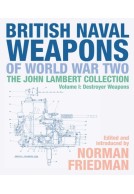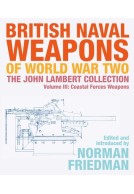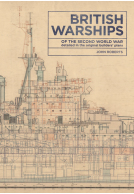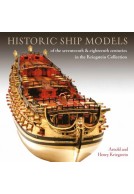British Destroyers & Frigates (Paperback)
The Second World War and After

Pages: 352
Illustrations: More than 200 b/w photos and ship profiles
ISBN: 9781526702821
Published: 17th May 2017
Last Released: 31st August 2021
(click here for international delivery rates)
Order within the next 2 hours, 4 minutes to get your order processed the next working day!
Need a currency converter? Check XE.com for live rates
Since the Second World War the old categories of destroyer and frigate have tended to merge, a process that this book traces back to the radically different Tribal class destroyers of 1936. It deals with the development of all the modern destroyer classes that fought the war, looks at the emergency programmes that produced vast numbers of trade protection vessels - sloops, corvettes and frigates - then analyses the pressures that shaped the post-war fleet, and continued to dominate design down to recent years.
Written by America's leading authority, it is an objective but sympathetic view of the difficult economic and political environment in which British designers had to work, and benefits from the author's ability to compare and contrast the US Navy's experience.
Norman Friedman is renowned for his ability to explain the policy and strategy changes that drive design decisions, and his latest book uses previously unpublished material to draw a new and convincing picture of British naval policy over the previous seventy years and more.
Hugely successful with enthusiasts and professionals alike from its first publication in 2006, this paperback is the book's third printing.
As featured by
Sea Breezes, April 2020
A solid work that certainly deserves a place in the bookcase.
Mercator, Jan/Feb/March 2018 – reviewed by Louis Van Cant
Norman Friedman is a highly regarded, prolific author on warship designs, particularly those for the Royal Navy.
Marine News
An excellent read and a valuable reference book, highly recommended to all interested in warship design and the new publication is the opportunity to acquire a copy if missed in 2006.
The book itself is well illustrated with over 200 photographs (in black and white) of vessels as well as ship plans by A D Baker III and detail drawings from Alan Raven. The book not only covers the Royal Navy but also Commonwealth vessels from Australian and Canada, among others...
Thomo's Hole - reviewed by Ian Thompson
This book is a must-have for anyone interested in the development of the Royal Navy through the second half of the 20th century.
Read the complete review here.
Everyone who did not get the old edition should obtain this one. It is essential reading for those who wish to understand the recent past of the Royal Navy.
Navy News, October 2017 – reviewed by Prof. Eric Grove
This a very valuable volume for anyone interested
Ships in Scale, Autumn 2017 – reviewed by Roger Marsh
in the history and development of the warships of
the 20th Century, particularly for British destroyers
and frigates of all types.
A comprehensive survey of the design history and development of the Royal Navy's greyhounds of the sea.
Warships IFR, September 2017 – reviewed by Peter Hore
As told by Friedman the destroyer saga from 1936 to the early 2000s is complex, exhibiting the constant battle between changing strategic challenges, staff requirements and available resources. The book is well illustrated and, as is usual in a Friedman warship design history, complemented by the peerless ship plans of A D Baker III. British Destroyers and Frigates is a must for the warship design enthusiast and historian.
Australian Naval Institute, Tim Coyle
Read the complete review here.
This is a large format book, just over A4 size, and weighing in at 352 pages, and it needs to be because it's covering a lot of Naval development!
Ship Modeller, Chris Meddings
Mr Friedman begins his narrative before WW2 with the development and design that produced the destroyers the Royal Navy took to war in 1939. Like all the following chapters this is profusely illustrated with clear photos printed at a decent size and some of Mr Baker's plans. Sadly the plans are not scaled but they are mostly quite large and are all very clear. If you know the recorded length of a certain vessel you can work out the scale from that and resize it with a scanner or photocopier if necessary.
The book moves on to 'Defending Trade', 'The War Emergency Destroyers' and 'new classes', 'Ocean Escorts' and a variety of other chapters covering all aspects of the vessels built for and during WW2 before turning to the postwar vessels of the period immediate after 1945.
The big change of course was the advent of the Missile Destroyer and this is discussed in detail in chapter 9. In this chapter we follow destroyer development up to the county class.
Chapter 11 begins the discussion of Frigates and the subsequent chapters follow their development to the Type 45.
The roles of the Destroyer and Frigate have changed dramatically over the last 80 years and this book does an admirable job of charting the changing technology and design that follows these changing demands over time.
For those less versed in Royal Navy history, there are a number of helpful sections in this book including the glossary at the start. The text is clear and easy to follow and Mr Fried,an explains his subject in a lively and interesting way.
This is a major study of British destroyers and smaller warships, first published in 2006, that remains unsurpassed. – This is impeccably researched book is very capably illustrated with photographs and drawings. It is offered at an incredibly aggressive price and is within reach of even the younger readers, but will remain a primary reference source for the topics covered – Highly Recommended.
Firetrench
Read the complete review here.
At the back of the book are yet more data tables, plus a list of all the various ship classes and the individual pennant numbers of each vessel within each class. It is an amazingly long list. I think it will be fascinating for many Royal Navy veterans interested in the ships they knew or served in as well as anyone with an interest in modern naval history. With so much information is will be a boon for the ship modeller as well. A great reference on an important class of Royal Navy warships from their use in WW2 and the changing developments over time since then. Well worth keeping on your bookshelf.
Military Model Scene, Robin Buckland
Read the complete review here.
The volume is well-written, researched and eminently readable. It is likely to appeal a variety of readers and may well become a standard reference work on its subject. The potential readership could include both naval personnel, and those with a general interest in the Royal Navy.. Those with a more general interest in naval and maritime matters are also likely to find this volume of interest. The many photographs and drawings are likely to be invaluable to both ship modellers and to marine artists with an interest in British naval vessels.
NZ Crown Mines
About Norman Friedman
NORMAN FRIEDMAN is arguably America’s most prominent naval analyst, and the author of more than thirty books covering a range of naval subjects, from warship histories to contemporary defence issues. His most recent titles in a series of successful works for Seaforth are the two volumes of his history of British Submarines.





















